

Of Mice and Men. OF MICE AND MEN. Of Mice and Men by John Steinbeck. Racism in the 1930s by Mrs. Bs Class on Prezi. Racism in the 1920s & 1930s. Race During the Great Depression - American Memory Timeline- Classroom Presentation. The problems of the Great Depression affected virtually every group of Americans.

No group was harder hit than African Americans, however. By 1932, approximately half of black Americans were out of work. In some Northern cities, whites called for blacks to be fired from any jobs as long as there were whites out of work. Racial violence again became more common, especially in the South. Lynchings, which had declined to eight in 1932, surged to 28 in 1933.
Although most African Americans traditionally voted Republican, the election of President Franklin Roosevelt began to change voting patterns. What are facts about racism in 1930s America. In the 1930s, the Ku Klux Klan was still active, but in a state of decline compared to the 1910s and 1920s.
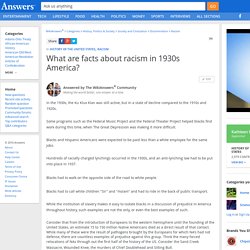
Some programs such as the Federal Music Project and the Federal Theater Project helped blacks find work during this time, when The Great Depression was making it more difficult. Blacks and Hispanic Americans were expected to be paid less than a white employee for the same jobs. American Experience. The Great Depression. Surviving the Dust Bowl . American Experience . WGBH. Schedule.

Race During the Great Depression - American Memory Timeline- Classroom Presentation. Of Mice and Men: Context. John Steinbeck was born in 1902 in Salinas, California, a region that became the setting for much of his fiction, including Of Mice and Men.
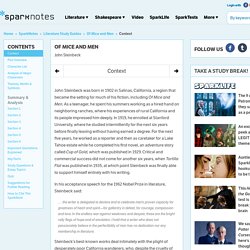
As a teenager, he spent his summers working as a hired hand on neighboring ranches, where his experiences of rural California and its people impressed him deeply. In 1919, he enrolled at Stanford University, where he studied intermittently for the next six years before finally leaving without having earned a degree. For the next five years, he worked as a reporter and then as caretaker for a Lake Tahoe estate while he completed his first novel, an adventure story called Cup of Gold, which was published in 1929. Critical and commercial success did not come for another six years, when Tortilla Flat was published in 1935, at which point Steinbeck was finally able to support himself entirely with his writing.
Of Mice and Men Analysis. Of Mice and Men - Steinbeck's Writing Style. Of Mice and Men: Context and Background. The New Deal: Crash Course US History #34. Of Mice and Men by John Steinbeck. The Great Depression: Crash Course US History #33. Of Mice and Men: Context and Background. A Century of Racial Segregation 1849–1950 - Brown v. Board at Fifty: "With an Even Hand" An elementary school in Hurlock, Maryland, ca. 1935.

Gelatin silver print. Brother, Can You Spare A Dime? Of Mice and Men: Plot Overview. Two migrant workers, George and Lennie, have been let off a bus miles away from the California farm where they are due to start work.
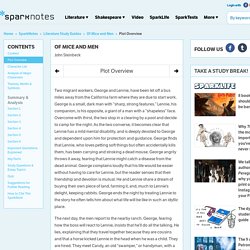
George is a small, dark man with “sharp, strong features.” Lennie, his companion, is his opposite, a giant of a man with a “shapeless” face. Overcome with thirst, the two stop in a clearing by a pool and decide to camp for the night. As the two converse, it becomes clear that Lennie has a mild mental disability, and is deeply devoted to George and dependent upon him for protection and guidance. George finds that Lennie, who loves petting soft things but often accidentally kills them, has been carrying and stroking a dead mouse. The next day, the men report to the nearby ranch. The next day, George confides in Slim that he and Lennie are not cousins, but have been friends since childhood.
Slim goes to the barn to do some work, and Curley, who is maniacally searching for his wife, heads to the barn to accost Slim. GCSE Bitesize: The Depression. Racism in the 1920s & 1930s. GCSE Bitesize: The Depression. Of Mice and Men by John Steinbeck. The History of Mental Illness. "Caring , and seeing with the heart.
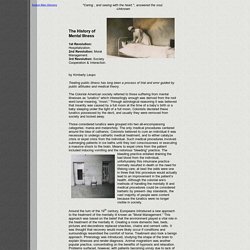
", answered the soul. -Unknown The History of Mental Illness 1st Revolution: Hospitalization. 2nd Revolution: Moral Management. 3rd Revolution: Society Cooperation & Interaction. by Kimberly Leupo Treating public illness has long been a process of trial and error guided by public attitudes and medical theory. The Colonial American society referred to those suffering from mental illnesses as ‘lunatics” which interestingly enough was derived from the root word lunar meaning, “moon.”
Those considered lunatics were grouped into two all-encompassing categories: mania and melancholy. Of Mice and Men: Themes, Motifs & Symbols. Themes Themes are the fundamental and often universal ideas explored in a literary work.
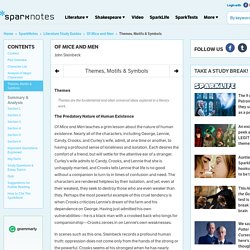
The Predatory Nature of Human Existence Of Mice and Men teaches a grim lesson about the nature of human existence. Of Mice and Men: Analysis of Major Characters. Lennie Although Lennie is among the principal characters in Of Mice and Men, he is perhaps the least dynamic.
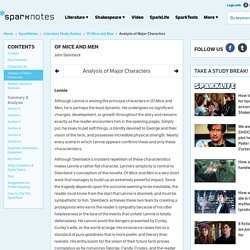
He undergoes no significant changes, development, or growth throughout the story and remains exactly as the reader encounters him in the opening pages. Simply put, he loves to pet soft things, is blindly devoted to George and their vision of the farm, and possesses incredible physical strength. Nearly every scene in which Lennie appears confirms these and only these characteristics. Although Steinbeck’s insistent repetition of these characteristics makes Lennie a rather flat character, Lennie’s simplicity is central to Steinbeck’s conception of the novella.
Race During the Great Depression - American Memory Timeline- Classroom Presentation. The History of Mental Illness: From "Skull Drills" to "Happy Pills" The limitlessly varied personalities of human beings have fascinated both scientists and fellow members of society throughout the existence of humankind.

Of particular interest has been what happens when man’s mind turns against him, and what can be done, if anything at all, to reverse this tragic event. Attempts to treat mental illness date back as early as 5000 BCE as evidenced by the discovery of trephined skulls in regions that were home to ancient world cultures (Porter 10). Early man widely believed that mental illness was the result of supernatural phenomena such as spiritual or demonic possession, sorcery, the evil eye, or an angry deity and so responded with equally mystical, and sometimes brutal, treatments.
Trephining (also referred to as trepanning) first occurred in Neolithic times. During this procedure, a hole, or trephine, was chipped into the skull using crude stone instruments. Of Mice and Men. Of Mice and Men is a novella[1][2] written by Nobel Prize-winning author John Steinbeck. Published in 1937, it tells the story of George Milton and Lennie Small, two displaced migrant ranch workers, who move from place to place in search of new job opportunities during the Great Depression in California, United States. Based on Steinbeck's own experiences as a bindlestiff in the 1920s (before the arrival of the Okies he would vividly describe in The Grapes of Wrath), the title is taken from Robert Burns' poem "To a Mouse", which read: "The best laid schemes o' mice an' men / Gang aft agley. " (The best laid schemes of mice and men / Often go awry.) Required reading in many schools,[3] Of Mice and Men has been a frequent target of censors for vulgarity and what some consider offensive and racist language; consequently, it appears on the American Library Association's list of the Most Challenged Books of 21st Century.[4] Plot summary Lennie accidentally kills his puppy while stroking it.
Race During the Great Depression - American Memory Timeline- Classroom Presentation. Of mice and men. The Migrant Experience - Voices from the Dust Bowl: the Charles L. Todd and Robert Sonkin Migrant Worker Collection, 1940-1941. A complex set of interacting forces both economic and ecological brought the migrant workers documented in this ethnographic collection to California. Following World War I, a recession led to a drop in the market price of farm crops and caused Great Plains farmers to increase their productivity through mechanization and the cultivation of more land.
This increase in farming activity required an increase in spending that caused many farmers to become financially overextended. The stock market crash in 1929 only served to exacerbate this already tenuous economic situation. Many independent farmers lost their farms when banks came to collect on their notes, while tenant farmers were turned out when economic pressure was brought to bear on large landholders. The attempts of these displaced agricultural workers to find other work were met with frustration due to a 30 percent unemployment rate.
Racism in the 1930s by Mrs. Bs Class on Prezi. What are facts about racism in 1930s America. Www.mercerislandschools.org/cms/lib3/WA01001855/Centricity/Domain/1457/OMAM Essay.pdf. Top 10 Notes: Of Mice and Men.
Of mice and men. Racism in 1930s America: Of Mice and Men Context - OxNotes GCSE Revision. The Dust Bowl Migration: Poverty Stories, Race Stories. Racism in the 1920s & 1930s.